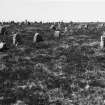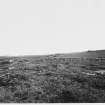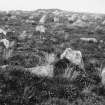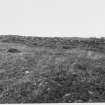Pricing Change
New pricing for orders of material from this site will come into place shortly. Charges for supply of digital images, digitisation on demand, prints and licensing will be altered.
Hill O' Many Stanes, Clyth
Stone Row(S) (Neolithic) - (Bronze Age)
Site Name Hill O' Many Stanes, Clyth
Classification Stone Row(S) (Neolithic) - (Bronze Age)
Alternative Name(s) Mid Clyth; Hill Of Many Stanes
Canmore ID 8604
Site Number ND23NE 6
NGR ND 29515 38405
NGR Description Centred ND 29515 38405
Datum OSGB36 - NGR
Permalink http://canmore.org.uk/site/8604
- Council Highland
- Parish Latheron
- Former Region Highland
- Former District Caithness
- Former County Caithness
ND23NE 6 centred 29515 38405
(ND 295 384) Stone Rows (NR)
OS 1:10,000 map, (1977).
See also ND23NE 12.
Twenty-two rows of standing stones, on the S slope of the Hill o' Many Stanes.
Dryden (J Anderson 1886), in 1871, noted 250 of which 192 remained erect in 1910.
The stones are generally thin slabs set with their faces looking across the rows and packed at the base with smaller stones. The largest are about 3 ft high, 3 ft wide and 15 to 18 ins thick.
To the E of the easternmost row, one or two protruding stones suggest that the monument may originally have extended further in that direction.
J Anderson 1886; RCAHMS 1911; R W Feachem 1963.
As described above. The stones radiate from the top of a rocky knoll to the N, an ideal position for a cairn, though there is no sign of one. That there have been rows immediately to the E is proved by the presence of small hollows edged with packing stones, although the stones themselves have disappeared.
Resurveyed at 1:2500.
Visited by OS (A A) 1 May 1967.
Publication Account (1995)
The best preserved example of these settings of small stones, which are unique to Caithness and Sutherland, is appropriately known as the 'Hill o' Many Stanes'. The stone rows run down the southern slope of a low hill. Around 200 stones are arranged in at least 22 rows running north and south, and fanning out slightly towards the south end. The small flat slabs are less than 1m high, and wedged carefully upright with their broad faces in line with the rows. In 1871 around 250 stones were visible, and if the pattern was once complete there may have been over 600 stones originally. There seems to be a main fan pattern in the centre, with a separate fan on the west that is bent towards the north end, and a few stray slabs on the east. The rows are generally regarded as of bronze-age date, but this is more or less guesswork, as no stone rows have yet been excavated in Scotland.
Information from ‘Exploring Scotland’s Heritage: The Highlands’, (1995).
Measured Survey (March 2003 - April 2003)
ND 295 384 A microtopographical and detailed archaeological survey of presumed prehistoric stone rows at Hill o' Many Stanes and environs was carried out in March and April 2003. The survey was undertaken as part of a management programme for the monument.
The monument consists of some 200 principal earthfast stones and a further 540 smaller stones set in 22 rows radiating northwards below the crest of a rocky knoll. The stones are not large, consisting of thin slabs, the largest being around 1m high and long and some 0.45m thick. The stones are set facing each other across the rows and are packed around their bases with smaller stones. There is some evidence of earthfast packers surviving on the E side of the site suggesting that the rows were once more extensive. A number of the stones are now recumbent and, at the time of the survey, smaller stones and low recumbents were obscured by heather, requiring some limited clearance. The site is adjacent to a minor road, which has cut the E side of the knoll and is separated from the site by a small quarry. There is a considerable amount of stone dumping in the field to the NW, but this is probably derived from more recent agricultural buildings than cleared stone from the monument.
Each stone was surveyed around its base and its upper edge to allow for monitoring of movement, and the characteristics of each were entered into a database to compare the results of previous unpublished surveys.
Archive to be deposited in the NMRS.
Sponsor: HS
A Dutton 2003.
Note (January 2017)
Stone rows, circles and settings
Scotland has numerous Neolithic stone rows, circles and settings, the most famous of which consist of large upright monoliths like those found at Callanish on the Isle of Lewis; Nether Largie in Kilmartin Glen, Argyll or at the Ring of Brodgar and Stones of Stenness on mainland Orkney. However, there are other fascinating and lesser known examples which are interesting for qualities other than their dizzying heights.
I clearly remember the first time I heard about the Hilly O’ Many Stanes during a lecture given by Dr Fraser Hunter of National Museums Scotland. He joked that the site should really be called the ‘Hill O’ Many Wee Stanes’, which only truly made sense when I visited the site a few months later. Located less than half a mile from the coastal cliffs at Clyth in Caithness, the site sits atop a rocky knoll, the slopes of which are coated with miniature standing stones. The stones are small compared to the great standing stones found elsewhere in the country; the largest one stands just a mere metre in height.
Hill O' Many 'Wee' Stanes
The stones were counted in 2003 and around 200 stones were recorded across the hilltop although earlier accounts suggest that originally there would have been many more. In 1871 around 250 stones were counted, but if the pattern was complete there may have been as many as 600. The stones have been laid out in at least 22 rows running from north to south, which fans out slightly towards the bottom of the slope. Each of the stones has been carefully placed and packed with smaller stones to help keep the stone upright. Stone rows like this one have only been found in the very north of mainland Scotland in the counties of Sutherland and Caithness.
The date of this site is uncertain, as it has never been excavated but archaeologists believe that it was likely constructed and used during the Neolithic or Bronze Age. What it was built for, who built it and for what purpose, remains a mystery. It may have been a gathering place, or a memorial, a religious or ceremonial centre or it may even relate to the stars. I often wonder though, if perhaps it served a function that we could only imagine in our wildest dreams. One thing is certain: the site would have taken time, effort and resources to construct, and therefore, must have been at one time a place of significance. What is even more remarkable is that for over 4000 years the residents of, and visitors to, the area have respected and protected the site and have ensured its survival.
Maya Hoole - Archaeology InSites project manager










































































































